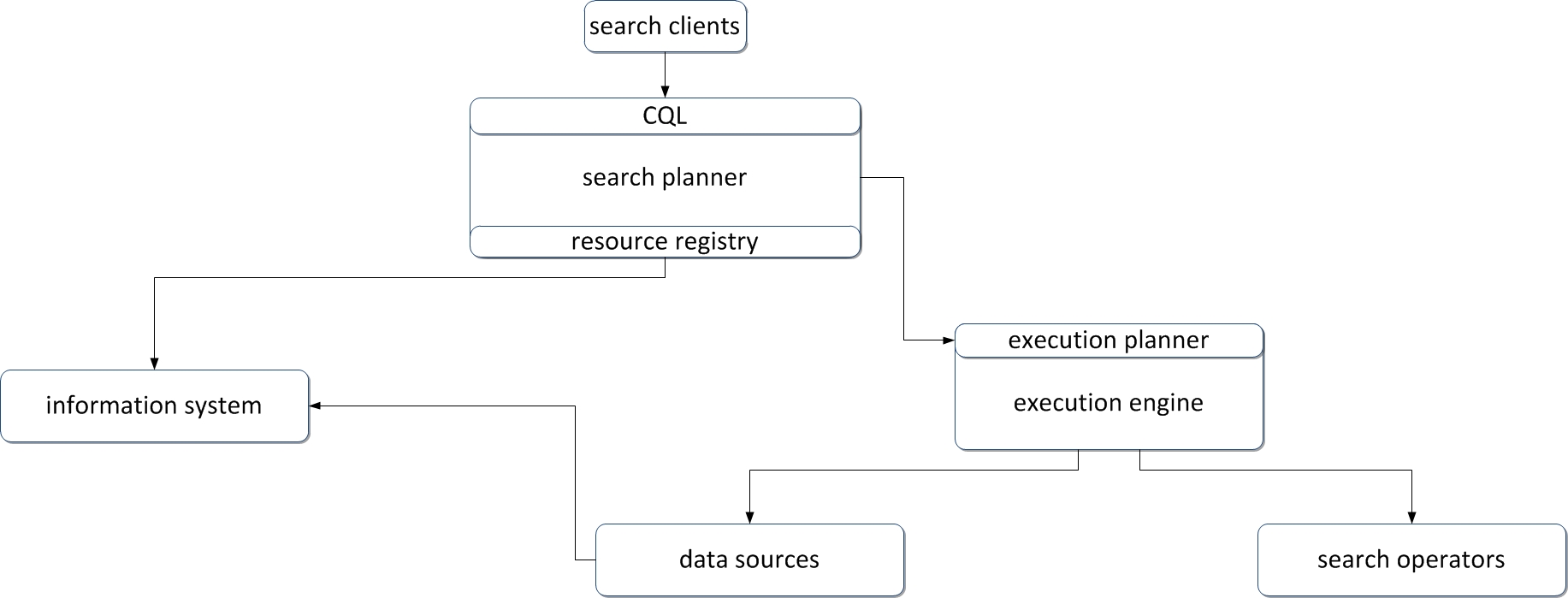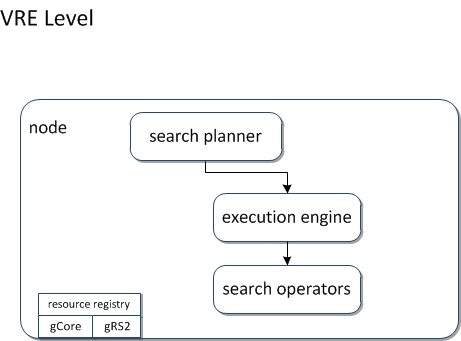Difference between revisions of "Search Planning and Execution Specification"
(→Design) |
Luca.frosini (Talk | contribs) |
||
| (18 intermediate revisions by 2 users not shown) | |||
| Line 38: | Line 38: | ||
=== Architecture === | === Architecture === | ||
| − | The | + | The main components of the Search system are the Planner, the Search Operators and the distributed Execution engine. The architecture is shown in the following figure: |
| − | [[Image:Search_system_architecture.jpg| | + | [[Image:Search_system_architecture.jpg|thumb|center|1000px|Search System Architecture]] |
| − | The | + | The Planner is aware of the available Data Sources, through the Resource Registry that provides an interaction mechanism with the [[gCore Based Information System]]. The Information System is used by Data Sources in order to publish their capabilities. Planner computes a plan for answering a [http://www.loc.gov/standards/sru/specs/cql.html CQL] query received by a search client. This plan contains also some hints about specific functionality required for the involved Search Operators. |
| − | + | The distributed Execution environment computes a preferred allocation for the execution of received plans through the Execution planner. | |
| − | + | During this procedure the possible invocation options for each Data Source and Search Operator are taken into account. The outcome of execution is the endpoint of a [[GRS2]] pipeline that can transfer the results to the search client that initiated the query. | |
| − | + | ||
| − | The | + | == Deployment == |
| + | The deployment schema must be decided based on: | ||
| − | + | 1. the workload from the search clients | |
| − | + | 2. the extent of the Data Sources' space | |
| − | + | === Large Deployment === | |
| + | Planner, Search Operators and Execution Engine are deployed over [https://gcore.wiki.gcube-system.org/gCube/index.php/Main_Page gCore] containers. The [[gRS2]] pipelining mechanism and the Resource Registry must also be part of the node. In case of a high frequency of received queries from search clients, a lot of Planner, Operators and Execution Engine instances have to be deployed. Such instances can be co-deployed for minimizing different types of overhead. A Planner instance can use only the co-deployed Execution Engine instance for the generation of execution plans. If Search Operators are also co-deployed on the same node, the Search System will be able to perform execution of the entire or part of the execution plan by exploiting the local resources, or in case the complexity of the execution plan is high, it can exploit the computational resources of all nodes where an Execution Engine is deployed. The following figure depicts a deployment configuration with multiple Search System endpoints where execution can be performed in a distributed manner with each node expoiting the computational capabilities both of itself and also of all other nodes. Another option for a deployment scenario could be to separate Search System endpoint nodes with execution nodes by maintaining a set of nodes with Planner and Execution Engine deployed and another set of nodes with Execution Engine and Operators. Deployment is usually performed on a [[VRE_Administration | VRE]] level. | ||
| − | + | [[Image:Search_system_deployment_large.jpg|frame|center|Search System Large Deployment]] | |
| − | + | ||
| − | + | === Small Deployment === | |
| − | + | In a smaller scale, with a small frequency of received queries and a reasonable Sources' space, only one node with Planner, Operators and Execution Engine co-deployed, is preferable. | |
| − | + | [[Image:Search_system_deployment_small.jpg|frame|center|Search System Small Deployment]] | |
| − | + | == Use Cases == | |
| − | + | The suitability of the Search System is based primarily on the characteristics of the underlying environment | |
| − | can | + | |
| − | + | === Well suited Use Cases === | |
| − | + | In cases where the environment's underlying information providers are CQL-compliant, gCube Search System can unify them and provide dynamic integration in the IR process. Additionally the optimization mechanisms it employs, in the planning and execution layer, offer high performance and scalability in case of large heterogeneous Data Sources' spaces. | |
=== Less well suited Use Cases === | === Less well suited Use Cases === | ||
| − | + | Less well suited cases are those where the underlying information providers can not be wrapped into gCube Data Sources through the CQL and [http://www.opensearch.org OpenSearch] standards, or through the [[Data_Sources_Specification | Index Data Source]]. These rare cases will mostly arise when the IR functionality of information providers can not be exploited using CQL expressions. | |
Latest revision as of 15:09, 19 October 2016
Contents
Overview
A fundamental part of the gCube Information Retrieval framework consists of the Search Planning and Execution components. The Search Planner enables the on-the fly integration of CQL-compliant Data Sources. The key concept in this process is the publication of CQL capabilities by the integrated Sources. The Search Planner will involve any of the Sources that have published their capabilities on a given infrastructure, as long as they contribute to the result for a query.
The optimization mechanisms of the Planner detect the smallest set of Sources required to answer a query. Moreover, using a probabilistic approach, a near-optimal plan for execution is found. The algorithms of the Planning and Optimization stages allow the IR framework to scale in the number of Data Sources that are integrated in an infrastructure.
Search Planner produces an plan that combines Data Sources and a selection from various Search Operators. A distributed execution environment ensures the efficient execution of the plan. Information travels from Data Sources to Search Operators and, in turn, to the Search clients through a pipelining data transferring mechanism that provides low latency, large throughput and a flow control facility.
Key features
- On-the-fly Integration of New Data Sources
- CQL-compliant Sources that publish their capabilities, are dynamically involved in the IR process.
- Involves the minimum number of Data Sources
- Detection of all the Sources that contribute to the result of a query.
- Scalability in the number of Sources integrated in an Infrastructure
- Planning and Execution components designed to scale.
- Dynamic Integration of New Search Operators
- Operators with new functionality can be dynamically integrated in the IR process.
- Pipelining Mechanism
- Offers flow control, low latency and high throughput.
Design
Philosophy
Search Planning and Execution components are designed in order to:
- allow the efficient and flexible integration of new Sources and Operators.
- exploit the IR capabilities and functionality of various information providers.
- scale in environments with a large number of heterogeneous Sources.
- decouple and eliminate the dependencies among the Planner, the Execution environment and the information providers.
Architecture
The main components of the Search system are the Planner, the Search Operators and the distributed Execution engine. The architecture is shown in the following figure:
The Planner is aware of the available Data Sources, through the Resource Registry that provides an interaction mechanism with the gCore Based Information System. The Information System is used by Data Sources in order to publish their capabilities. Planner computes a plan for answering a CQL query received by a search client. This plan contains also some hints about specific functionality required for the involved Search Operators.
The distributed Execution environment computes a preferred allocation for the execution of received plans through the Execution planner. During this procedure the possible invocation options for each Data Source and Search Operator are taken into account. The outcome of execution is the endpoint of a GRS2 pipeline that can transfer the results to the search client that initiated the query.
Deployment
The deployment schema must be decided based on:
1. the workload from the search clients
2. the extent of the Data Sources' space
Large Deployment
Planner, Search Operators and Execution Engine are deployed over gCore containers. The gRS2 pipelining mechanism and the Resource Registry must also be part of the node. In case of a high frequency of received queries from search clients, a lot of Planner, Operators and Execution Engine instances have to be deployed. Such instances can be co-deployed for minimizing different types of overhead. A Planner instance can use only the co-deployed Execution Engine instance for the generation of execution plans. If Search Operators are also co-deployed on the same node, the Search System will be able to perform execution of the entire or part of the execution plan by exploiting the local resources, or in case the complexity of the execution plan is high, it can exploit the computational resources of all nodes where an Execution Engine is deployed. The following figure depicts a deployment configuration with multiple Search System endpoints where execution can be performed in a distributed manner with each node expoiting the computational capabilities both of itself and also of all other nodes. Another option for a deployment scenario could be to separate Search System endpoint nodes with execution nodes by maintaining a set of nodes with Planner and Execution Engine deployed and another set of nodes with Execution Engine and Operators. Deployment is usually performed on a VRE level.
Small Deployment
In a smaller scale, with a small frequency of received queries and a reasonable Sources' space, only one node with Planner, Operators and Execution Engine co-deployed, is preferable.
Use Cases
The suitability of the Search System is based primarily on the characteristics of the underlying environment
Well suited Use Cases
In cases where the environment's underlying information providers are CQL-compliant, gCube Search System can unify them and provide dynamic integration in the IR process. Additionally the optimization mechanisms it employs, in the planning and execution layer, offer high performance and scalability in case of large heterogeneous Data Sources' spaces.
Less well suited Use Cases
Less well suited cases are those where the underlying information providers can not be wrapped into gCube Data Sources through the CQL and OpenSearch standards, or through the Index Data Source. These rare cases will mostly arise when the IR functionality of information providers can not be exploited using CQL expressions.


